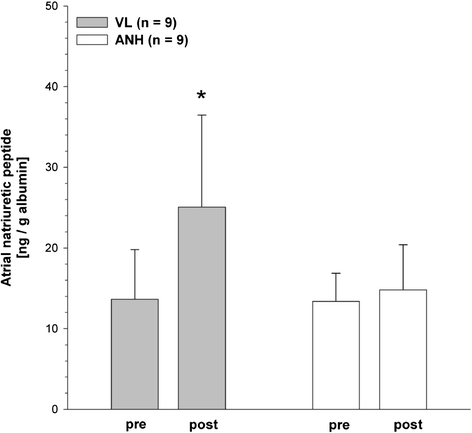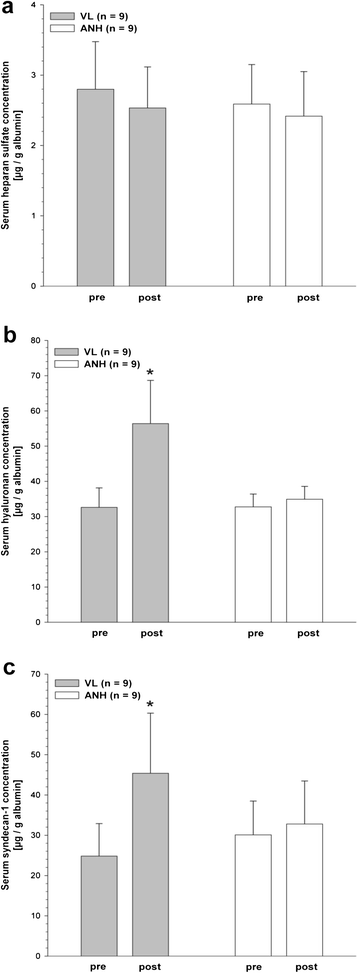Hypervolemia increases release of atrial natriuretic peptide and shedding of the endothelial glycocalyx
- PMID: 25497357
- PMCID: PMC4201669
- DOI: 10.1186/s13054-014-0538-5
Hypervolemia increases release of atrial natriuretic peptide and shedding of the endothelial glycocalyx
Abstract
Introduction: Acute normovolemic hemodilution (ANH) and volume loading (VL) are standard blood-sparing procedures. However, VL is associated with hypervolemia, which may cause tissue edema, cardiopulmonary complications and a prolonged hospital stay. The body reacts to hypervolemia with release of atrial natriuretic peptide (ANP) from the heart. ANP has been shown to deteriorate the endothelial glycocalyx, a vital part of the vascular permeability barrier. The aim of the present study was to evaluate and compare ANP release and damage to the glycocalyx during ANH and VL.
Methods: ANH or VL with 6% hydroxyethyl starch 130/0.4 was administered prior to elective surgery in patients of good cardiopulmonary health (n =9 in each group). We measured concentrations of ANP in plasma and of three main constituent parts of the glycocalyx (hyaluronan, heparan sulfate and syndecan 1) in serum before and after ANH or VL. Heparan sulfate and syndecan 1 levels in urine were also determined.
Results: In contrast to ANH, VL (20 ml/kg) induced a significant release of ANP (approximately +100%, P <0.05) and increased the serum concentration of two glycocalyx constituents, hyaluronan and syndecan 1 (both by about 80%, P <0.05). Elevation of syndecan 1 was also detected in the urine of patients undergoing VL, but no increase was found in patients undergoing ANH. Heparan sulfate levels were not influenced by either procedure.
Conclusion: These data suggest that hypervolemia increases the release of ANP and causes enhanced shedding of the endothelial glycocalyx. This perturbation must be expected to impair the vascular barrier, implying that VL may not be as safe as generally assumed and that it should be critically evaluated.
Figures



Comment in
-
Fluid resuscitation should respect the endothelial glycocalyx layer.Crit Care. 2014 Dec 23;18(6):707. doi: 10.1186/s13054-014-0707-6. Crit Care. 2014. PMID: 25629597 Free PMC article.
References
Publication types
MeSH terms
Substances
LinkOut - more resources
Full Text Sources
Other Literature Sources
Medical

